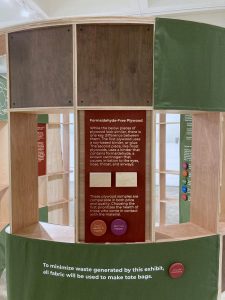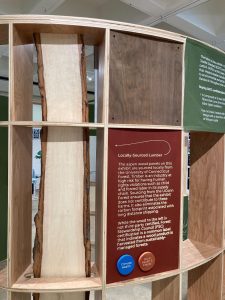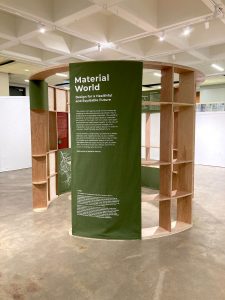Material World: Design for a Healthful and Equitable Future
Fall 2022 UConn Co-op Legacy Fellowship – Change Grant Project
Material World: Design for a Healthful and Equitable Future is a sustainably-built pop-up exhibit educating students on the impacts of environmentally and socially sustainable design methods and materials, with the goal of empowering them to act as agents of change in their professional careers and personal lives. It acts as a proof-of-concept for sustainable design.
The project has two parts: the physical exhibition and a digital biography. The physical exhibition primarily uses four materials, formaldehyde-free plywood, locally-sourced lumber, organic cotton canvas, and mycelium, with a variety of sustainable finishes. Each material fits into the following guideline, set early in the project: “Materials acquired will fit into one or more of the following categories: locally sourced within a fifty mile radius of Storrs, Connecticut; reclaimed; reusable; and/or compostable in a non-industrial setting. Additionally, I endeavor to eliminate the use of petroleum-based plastics.”
 The digital biography for the project includes an exploration of concept and design development, deep dives into each material in the exhibit, and a comprehensive list of resources that informed exhibit development. It can be viewed at www.cameronslocum.com/materialworld.
The digital biography for the project includes an exploration of concept and design development, deep dives into each material in the exhibit, and a comprehensive list of resources that informed exhibit development. It can be viewed at www.cameronslocum.com/materialworld.
I am grateful to have received support from the Change Grant, the Environmental and Social Sustainability Small Grants Program (University of Connecticut Institute of the Environment and Office of Sustainability), as well as from the Connecticut State Museum of Natural History.
Impact
Material World was first displayed in the 2023 BFA Studio Art Exhibition in the Art Building, and then in the Gant Science Complex Light Court from July 2023 through December 2023. During the summer, all of the prospective student tours began in the Gant Science Court Light Complex, thus exposing hundreds of prospective students and their families to Material World. Additionally, by installing the exhibit in both arts-centric and science-centric locations, I have reached audiences from diverse fields that are often viewed as unrelated, even though collaborations between the disciplines can yield fruitful results. Material World, for instance, brought together art, design, engineering, human rights, and science in the same project. On multiple occasions, my partners at the University told me that my project had connected them with people in different departments.
 Additionally, I received feedback from students that they read or have seen people reading the interpretive text. Multiple visitors reported to me that they learned something new, most often regarding mycelium, through Material World. On several occasions, I witnessed people touching the materials in the exhibit, something I explicitly invite visitors to do in my introductory text. This is encouraging to me, as it suggests that the educational aspects of the exhibit are successful.
Additionally, I received feedback from students that they read or have seen people reading the interpretive text. Multiple visitors reported to me that they learned something new, most often regarding mycelium, through Material World. On several occasions, I witnessed people touching the materials in the exhibit, something I explicitly invite visitors to do in my introductory text. This is encouraging to me, as it suggests that the educational aspects of the exhibit are successful.
Not only has the project impacted the campus community, but it has also been an incredible opportunity for me to learn about and engage in exhibit design, a field I plan to enter post-graduation. I managed the entire project, including grant applications, concept development, research, design, text writing and editing, communication with partners and contractors, fabrication, and installation, as well as the development of the digital biography. These experiences are directly transferable to a professional career.
I also gained many great connections, including with students, faculty, and staff at UConn, as well as with professionals in the museum field with whom I have had fruitful conversations about Material World. Although my work on the project is largely concluded, I hope that it continues to be a resource that informs both my own and others’ work.
Special thanks to my mentor, Chris Sancomb, and to everyone at the University of Connecticut who supported me in the creation of this exhibit, including: Bianca Ibarlucea, Gary Krewson, and John O’Donnell (Art and Art History); Beth Barbeau, Janine Caira, Erin Kuprewicz, and Mel Stinnett (Connecticut State Museum of Natural History); Shareen Hertel (Political Science and Human Rights); and Melissa Berkey and John Harbison (Office of Undergraduate Research).
